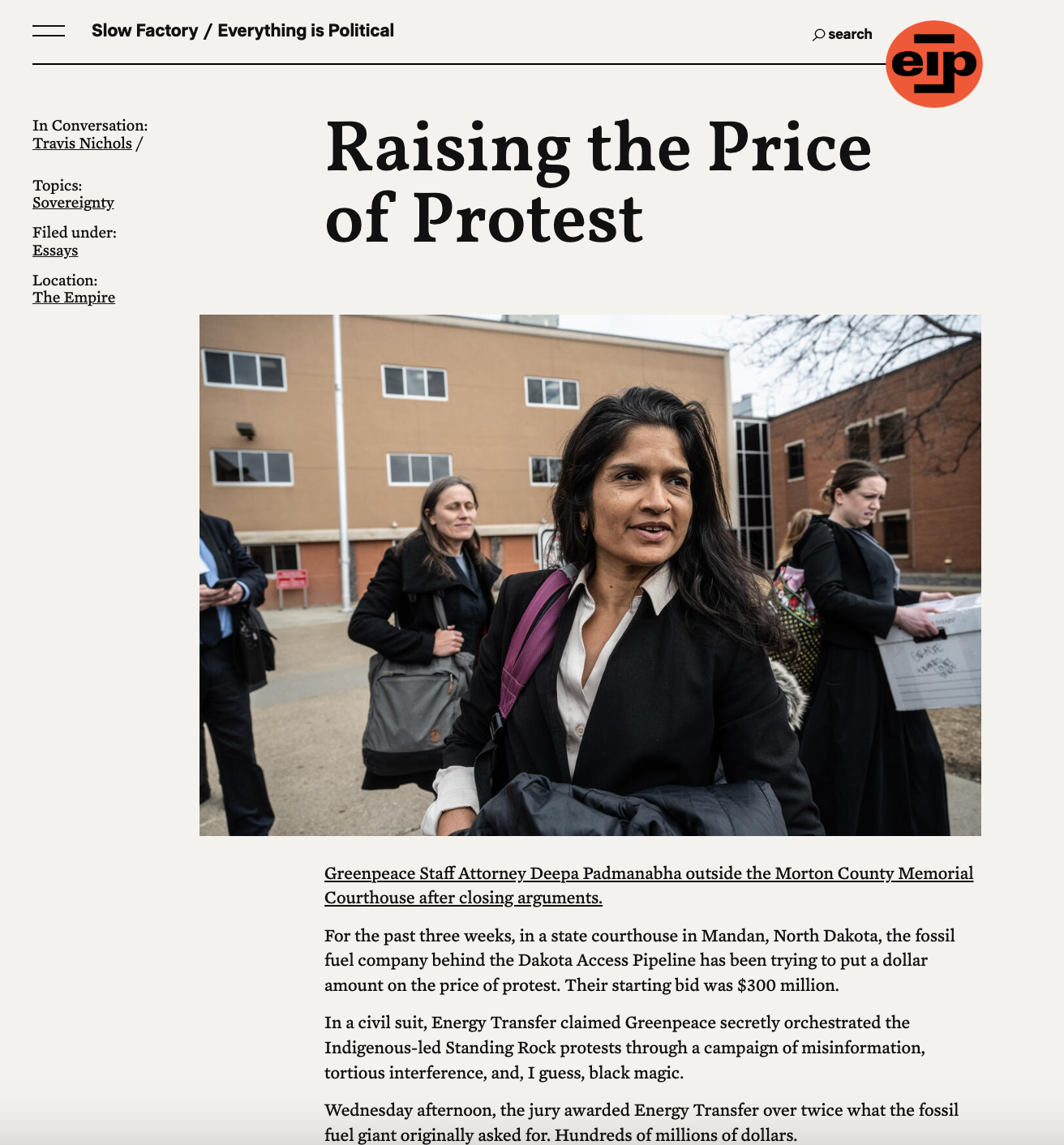Object Lesson
TLDR:
As a writer, content* producer, and extremely online reply guy, I’ve found it’s useful to break “news” down into three basic categories: What?, So What?, and Now What?
The two pieces I wrote about the Greenpeace trial in North Dakota — one for Everything is Political, and one for Rolling Stone — can serve, I hope, as a kind of object lesson for different ways to engage with the news cycle through these three basic categories.
What?
What? content is the classic, inverted pyramid style news stuff. You have essential information and you want to get it out into the world as clearly and quickly as possible. This is the raw information, the facts of the case. In North Dakota, the courtroom was small, phones were banned, and there wasn’t a public livestream, so, when the decision from the jury came in, readers wanted the details of the verdict itself as quickly and clearly as possible.
This was the What? content, the breaking news.
The Associated Press delivered, as they often do, the “What?”
So What?
Next, comes the So What? content.
These pieces explain why the new information matters, why it’s worth your attention. So What? content provides context and analysis that was likely missing from the breaking news What? pieces that preceded it. Which makes sense, because once the basic facts are out there, the next question readers and viewers ask is: Why does this matter?
The North Dakota jury delivered its decision? So what?
This is where interpretation, context, and perspective enter.
In the Greenpeace case, different parties offered different spins: Energy Transfer and its boosters portrayed the verdict as a justified punishment for what they claimed was defamation and economic sabotage.
Free speech and environmental advocates, on the other hand, framed it as a travesty of justice:
The “so what” stories connected the verdict to broader themes: the rights of protestors, the responsibilities of advocacy groups, the power of corporations, and the future of legal protections in America. These types of pieces might include expert commentary, analysis of legal precedent, or summaries of related cases.
That is what I tried to do in my piece for Everything is Political. I wanted to put the implications of the verdict and the implications of the Trump administration’s crackdown on protests together.
The “So What?” space is usually crowded with reply-guys and hot take machines, so it’s always good to ask whether or not you have anything of unique value to add to the conversation.
Will your “So What?” answer be different from anyone else’s? Is piling on helpful? If not . . . maybe go back into that Google Doc and workshop a bit? Or, maybe wait for the next category of story, the “Now What?”
Now What?
The “Now What?” stories build on the “So What?” stories to explain how this moment, and the context, might shape the future, and why it’s worth understanding now in order to have a better sense of why future “What?” stories matter.
Audiences want to know: What happens next? The “now what” stories project forward. How will the decision affect future protests? What will it mean for Greenpeace’s operations? Will it change how corporations pursue litigation against activist groups?
This kind of analysis usually emerges after the initial wave of reporting and early commentary.
In this case, stories began addressing what the ruling might signal about the landscape for advocacy and protest moving forward. Will more fossil fuel companies take similar legal action? Will activist organizations change how they communicate or organize?
The "now what" phase often contains elements of both the "what" and the "so what" but leans into synthesis and forecasting. It helps audiences integrate the event into a longer timeline of related developments.
After reading existing coverage, I thought I recognized a narrative gap: few outlets explained why Greenpeace was vulnerable to this kind of lawsuit in the first place.
My follow-up piece for Rolling Stone explored that deeper context—why the organization’s consistent stance and tactics had made it a target, and what that said about the broader activist landscape.
That piece became part of the “now what” conversation. It added texture and insight to a moment that was still unfolding, and it demonstrated how journalists and advocates can play a role in shaping public understanding after the news has broken.
BONUS CATEGORY: WTF?!?!
Of course, the Trump administration has opened wide a space for a new content category — WTF!?!?! — but, as we should have learned from the first Trump term, this type of content, while initially engaging, quickly becomes exhausting and demoralizing.
My hope is that by understanding how news moves through these phases—what, so what, now what—we as communicators, activists, journalists, and extremely online reply guys can become more effective in getting attention, making the invisible visible, and changing the culture and discourse in meaningful ways beyond just WTF?!?!
All typos are the fault of the machine overloards











